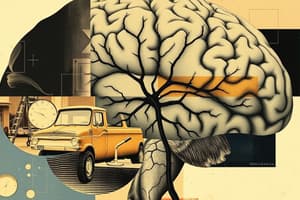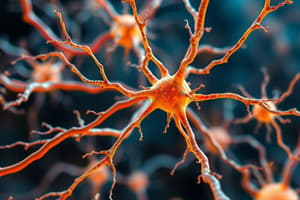Podcast
Questions and Answers
What is the main function of interneurons in the nervous system?
What is the main function of interneurons in the nervous system?
- Carrying signals from CNS to muscles and glands
- Generating electrical signals within the CNS
- Conveying information between sensory and motor neurons (correct)
- Transmitting sensory information from PNS to CNS
Which part of a neuron receives signals from other neurons?
Which part of a neuron receives signals from other neurons?
- Cell body
- Nerve impulse
- Axon
- Dendrites (correct)
How is communication between neurons primarily facilitated?
How is communication between neurons primarily facilitated?
- Via hormonal signals
- Through electrical impulses (correct)
- By neurotransmitters
- By mechanical vibrations
What is the role of motor neurons in the nervous system?
What is the role of motor neurons in the nervous system?
What type of neurons transmit information about touch, temperature, pain, or pressure?
What type of neurons transmit information about touch, temperature, pain, or pressure?
What are the two main components of the nervous system?
What are the two main components of the nervous system?
Which part of the brain is primarily responsible for higher cognitive functions like thinking and reasoning?
Which part of the brain is primarily responsible for higher cognitive functions like thinking and reasoning?
What is the main function of the cerebellum in the brain?
What is the main function of the cerebellum in the brain?
Which region of the brain is crucial for regulating consciousness and processing sensory information?
Which region of the brain is crucial for regulating consciousness and processing sensory information?
What does the spinal cord extend from according to the text?
What does the spinal cord extend from according to the text?
Flashcards are hidden until you start studying
Study Notes
The Nervous System: Understanding Central Nervous System and Neurons
The nervous system is a complex, intricate network of cells that enables us to perceive, process, and act upon the world around us. This extensive communication system is divided into two main components: the central nervous system (CNS) and the peripheral nervous system (PNS). In this exploration, we'll delve into the CNS and its fundamental building blocks, neurons.
The Central Nervous System
The CNS is the control center for the nervous system, receiving, processing, and integrating information from the sensory organs. It consists of two major parts: the brain and the spinal cord.
The brain, the most complex organ in the human body, is divided into various regions responsible for different tasks. The cerebrum is the largest part of the brain and is primarily responsible for higher cognitive functions such as thinking, reasoning, and decision-making. The cerebellum, located at the back of the brain, is in charge of coordination, balance, and fine motor skills. The brainstem and diencephalon are crucial for functions like regulating consciousness, controlling breathing and circulation, and processing sensory information.
The spinal cord, a long, cylindrical structure, extends from the base of the brain to the level of the second lumbar vertebra. It serves as a vital link between the brain and the rest of the body, passing on sensory information from the PNS and relaying signals to various muscles to help us perform actions.
Neurons: The Building Blocks of the Nervous System
Neurons, also known as nerve cells, are the fundamental units of the nervous system. There are three main types of neurons: sensory neurons, motor neurons, and interneurons.
- Sensory neurons or afferent neurons transmit information about external stimuli from sensory receptors to the CNS. This information may include touch, temperature, pain, or pressure.
- Motor neurons or efferent neurons carry signals from the CNS to muscles and glands, causing them to contract or secrete substances, respectively. For example, when you decide to move your finger, motor neurons transmit that information to the muscles in your finger, leading to contraction.
- Interneurons, also known as relay neurons, are located entirely within the CNS. They convey information between sensory and motor neurons, helping to process, integrate, and respond to various stimuli.
Each neuron has a cell body, dendrites, and an axon. Dendrites are tree-like extensions of the cell body that receive signals from other neurons. Axons, on the other hand, are long, slender extensions of the cell body that transmit signals to other neurons, muscles, or glands.
The communication between neurons is facilitated by a specialized chemical/electrical signal called a nerve impulse, or action potential. When the strength of a stimulus exceeds a neuron's threshold, the neuron generates an electrical signal that travels down the axon and, if the signal reaches the axon terminals, a chemical signal is released. This chemical signal is detected by another neuron (or muscle or gland cell) and can cause that neuron to generate its own electrical signal.
The nervous system is a complex and fascinating system that allows us to function and thrive. Understanding the central nervous system and neurons, its fundamental components, is the first step in appreciating the intricate dance of communication that enables our thoughts, actions, and emotions.
Studying That Suits You
Use AI to generate personalized quizzes and flashcards to suit your learning preferences.




